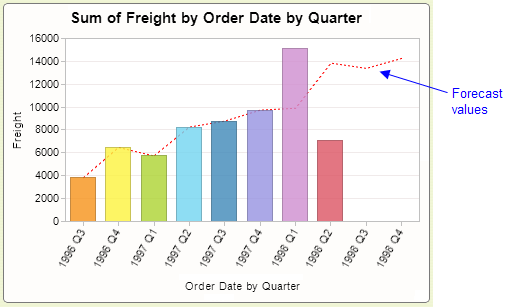The Forecasting Elements
Forecasting elements use a variety of techniques to produce projected values by analyzing existing values. The future values they "predict" are, in most cases, added as rows or columns to a datalayer so the data can be displayed along with the existing data.
The following topics discuss Forecasting elements:
About Forecasting
Data forecasting is the process of generating values based on events that have not yet occurred. "Prediction" is a similar but more general term. Forecasting refers to formal, statistical methods that use time series, cross-sectional, or longitudinal data.
Logi Forecast elements are applied as the children of datalayer elements (forecasting features available in some of our "super elements", such as the Analysis Chart, use separate elements and attributes that enable them). The forecasted data values are generated by analyzing the existing values in the datalayer, and the resulting "future" values are added to the datalayer so they can be displayed along with the existing values.

Typically, forecasts are displayed most effectively on charts. In the example shown above, quarterly freight costs have been forecast using a Time Series Decomposition method and are displayed as a dotted line on a bar chart. Data that best lends itself to forecasting can be:
- Time Series, consisting of data in a natural time-related order with a strong interval, where the "independent data" (X-axis) is of DateTime type and the "dependent data"(Y-axis) is a number. For example, "Product Sales by Month".
- Causal, consisting of dependent numeric values ordered by a numeric independent variable. Example: a count of unique website visitors and a count of the number of ads they clicked on.
There is no single correct forecasting method to use in any given situation. There are a large number of methods, including the following just for time series forecasts:
- Moving average
- Weighted moving average
- Exponential smoothing
- Autoregressive moving average (ARMA)
- Autoregressive integrated moving average (ARIMA) e.g. Box-Jenkins
- Extrapolation
- Linear prediction
- Trend estimation
- Growth curve
- Regression analysis
Some of these methods are easy to understand and some are not. The Logi Forecast elements use a combination of some of these methods.
Forecasting Methodologies
Our reference topic, Forecast Methodologies, provides more detailed information about our forecasting implementations.